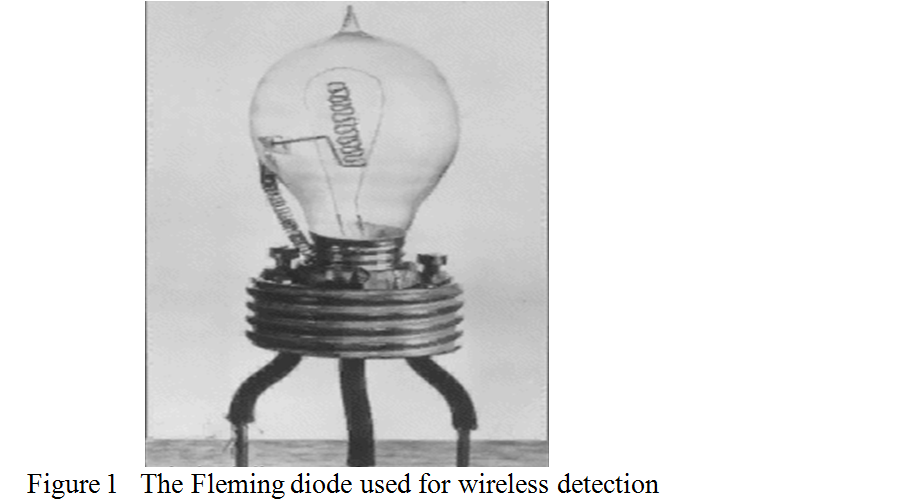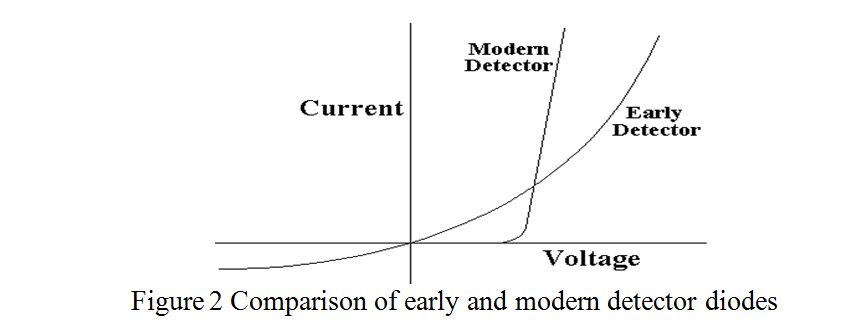The coming of the diode
Back
Although the strange and useful properties of slightly strange combinations of materials had been observed in the very early days of experiments with Hertzian or wireless waves, they had not been intensively investigated or put to extensive use. The first of these strange combinations was attributed to the Anglo-American inventor David Edward Hughes, who, in 1879 discovered that a loose contact between a steel point and a carbon block would not conduct direct current, but that if electromagnetic waves were passed through the junction point, it conducted well. He demonstrated the reception of radio signals from a spark transmitter located some hundreds of meters away, but this form of detector was not pursued at the time as coherer detectors were already achieving ranges of several miles. A pity really, and a lost opportunity, as rectifier detectors then had to be re-discovered some 25 years later.
Another lost opportunity occurred in 1883, when Edison first observed the flow of current through a partial vacuum between the hot filament of a modified lamp bulb and a metal plate. But, in the days before thoriated tungsten and coated filaments, such currents were extremely low. Also, the very nature of electricity was barely understood, and wireless waves even less so. There were no oscilloscopes for observing the transmitted or received waveforms, or for seeing and understanding the action of rectification producing “half sine waves”. In fact, although through hundreds of experiments, quite good practical results were being achieved, the mechanism of the detection process was still a great mystery. Remember, the electron was only discovered in 1897. Against this background and amongst this ignorance, in 1904 Dr. Ambrose Fleming repeated Edison’s experiment using a hot filament and a bent metal wire in an evacuated lamp bulb and immediately applied it to the detection of wireless waves. Although it was successful, the poor cathode emission of early filaments meant that it did not immediately replace either the coherer or the magnetic detector.
A photograph of Fleming’s diode, with the anode looking more like a grid than a plate is shown in figure 1 below.

Improvements were also being made in other areas. Prior to 1904, any tuning was carried out by “tapping” the inductor, sometimes known as a “jigger”. In that year however, C. S. Franklin designed the first rotary plate variable capacitor which made tuning much easier.
In 1905, an American, General Dunwoody, improved Hughes’ original device of 1879 and announced his Carborundum Detector. This immediately stimulated interest and soon led to various other and better “solid state” or “crystal” detectors, the best known of which is the Galena or cat’s whisker detector. Galena is the natural ore from which lead is obtained and is mainly lead sulphide with usually a little silver sulphide. The other really significant event of 1905 was that the American, Lee de Forest, bought some samples of Fleming’s modified lamp bulbs and took some of them to a New York lamp maker and had another electrode inserted into them. (This was later called a grid though de Forest didn’t use this term). He soon discovered that by putting different voltages on the grid, he could alter the plate current, and thus was born the first triode, but there is evidence that he never really understood the mechanism of how it worked. More of the triode later.
The crystal and cat’s whisker was a troublesome device, as anyone who has experimented with it will tell you. You first have to find a good spot on the crystal with the point of the cat’s whisker, and some spots work better than others. The bits that work well are often only the size of the cat’s whisker point, and then you have to keep the point there. However, when you find a really good spot, a galena crystal is nearly as good at a modern signal diode. You might have thought that the invention of the thermionic diode was a huge improvement and the cat’s whisker would soon be relegated to history. It was an improvement as regards reliability, in that you only had to turn on the filament supply and it was ready, with no further adjustments. However, the poor emission of early thermionic diodes rendered them less sensitive than cat’s whisker detectors, and the latter remained the predominant form of wireless receiver after general broadcasting began, right up to the middle of the 1920s. However, at sea, where reliability was paramount, the “Maggie” was well established, but a thermionic diode detector was often kept as a standby. In fact, a diode detector alongside a magnetic detector is visible in a contemporary photograph of the wireless room of the “Olympic”, a sister ship of the “Titanic”.
On a personal note, I remember when I was about 10, my grandfather recalled that he had experimented with a crystal set just before the First World War, but that during that war, they were banned. So he took down the long high aerial wire that ran down his garden in London, and replaced it with a long low wire that ran alongside his garden wall, and he sometimes illegally listened to Morse transmissions, though he didn’t understand them. I too experimented with crystal sets from about the age of 10, and bought various components with my pocket money, including a very superior “Tellurium-Zinc crystal detector”. This is what nowadays would be called a “Perikon” detector. It comprised a piece of crystalline zinc set in a fixed holder and a spring loaded arm with a little handle at one end and a yellow crystal of tellurium at the other. It was greatly superior to the ordinary cat’s whisker device and almost anywhere you placed the tellurium on the zinc seemed to work equally well.
Various other combinations are reported to have worked of which the most recent, before any proper understanding of how they worked was reached, was the copper-copper oxide combination. These were sold with various numbers of similar elements in series, under the name of “Westectors”, and were frequently used in World War ll military receivers. The other popular rectifying material was selenium, which could be made with a quite large surface area junction, and was mainly used for power rectifiers, as in “High Tension Battery Eliminators”. Selenium was also the first useful material to be used in photo cells, as in early flying spot television experiments.
There was no real understanding of how these devices and materials worked in the early days of the last century, people were just happy that they did! Understanding the mechanism of solid state rectification, and of semi-conductors in general had to wait for the demise of the “Plum Pudding” model of atoms, and the ascendance of the Bohr model of the atom with its orbiting electrons, and quantum theory, with its discreet energy levels. Even then, true understanding had to wait for the intensive research which followed the almost accidental discovery of the “Transferred Resistance effect” by Brattain, Houser, and Shockley at the Bell Telephone Laboratories in 1948, for which they got the Nobel Prize in physics in 1956.
Early cat’s whisker type detectors had very poor “forward to reverse resistance ratios” compared with modern diode rectifiers, but they had one slight advantage for the detection of weak signals. They had no clearly defined “knee voltage” below which there was virtually no conduction. They had a roughly square law current versus voltage characteristic right through the origin, rather than the offset exponential law of modern detector diodes. The difference is depicted in figure 2 below
Nevertheless, the square law characteristic gives quite acceptable demodulation of simple Amplitude Modulated received signals.

Again, on a personal note, I carried out some comparative experiments with a Cat’s whisker and Galena type crystal and compared it in my crystal set, (shown in Part lV), with some modern Silicon and Germanium diodes. All the modern diodes worked well on strong signals and of course there were no adjustments to make other than tuning. But interestingly, the very best spots on the crystal and cat’s whisker combination worked equally well, but it was enormously difficult to find the best spot and to keep the point of the cat’s whisker on it. Nevertheless, crystal sets were widely used throughout the 1920s with high impedance headphones. If you were fortunate enough to live within a few miles of the transmitter, (2 MT in Writtle near Chelmsford, or 2 LO in London), the whole family could listen by placing the headphones in a bowl in the centre of the table and all leaning forward with one ear over the bowl.
In the next and last part of this series I will describe the invention of the triode and amplification which takes us out of the historical era of wireless and into modern electronics.
| Back |
|---|
John G0NVZ